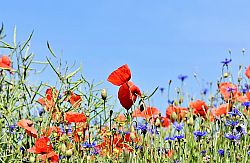

According to the new guidelines published by a charity Plantlife, the UK has a great potential to enjoy around 400 bn more flowers if road verges were cut later and less often by the local councils.
With verges running along most rural roads, which stretch along almost 313,500 miles in the UK, it could mean that an area equivalent to the size of London, Birmingham, Manchester, Cardiff and Edinburgh combined would turn into a flowery grassland habitat of national significance.
Today, the majority of the UK’s grass road verges are either cut too frequently and at the wrong time, or abandoned to scrub. Cuttings are left to lie creating a thick thatch, inhibiting growth and increasing soil nutrient levels, which further stimulates vigorous grasses and other nutrient-loving plants.
According to Plantlife, this cycle increases on-going management costs and negatively impacts on the safe functioning of the highway. These unintended consequences are largely due to inappropriate management contracts, focused on safety considerations with little or no consideration of potential wider benefits. The new guidance offers a different approach, which could lead to the improvements in biodiversity, reduction of the growth of vegetation, lower costs for verge management, improves the natural capital value, resulting in more sustainable operations and reduced carbon footprint.
Almost 97% of wildflower meadows in the UK have been destroyed this century, roadside grassland has become a crucial wildlife habitat for over 700 species of wildflowers, including rare species, such as the lizard orchid.
This transformation was found to be necessary to create "more, bigger, better and joined up" habitats and "making safe space for nature" in keeping with the government's recommendations while taking into account road safety recommendations and focusing on the areas where there are no safety constraints restricting management.
The guidance recommends different cutting strategies for different types of grassland, but with several key principles, including no cutting before the end of July and all the grass cuttings to be removed to lower soil fertility and allow a more diverse range of wildflowers to grow.
The charity accepts that some road users might view the verges as "untidy and neglected" but says that land managers can cut narrow strips around the wider verges to frame them, providing the perception of tidiness and help offset the potential negative feedback.